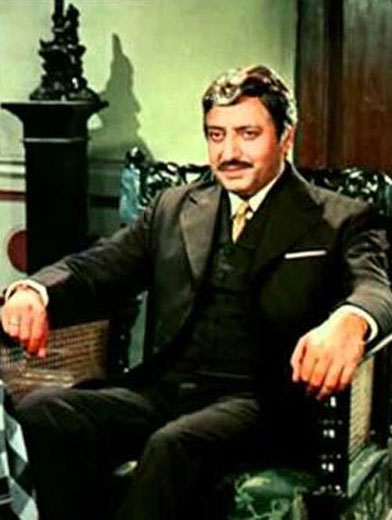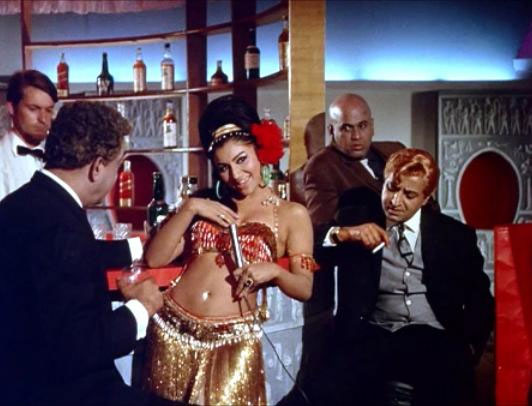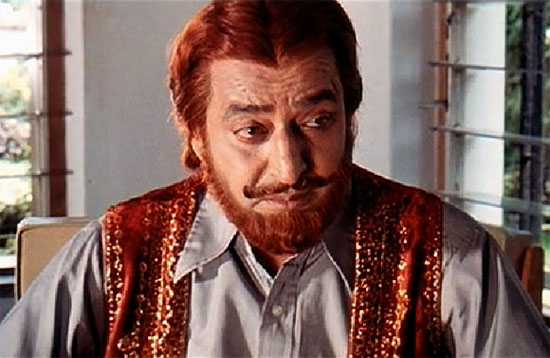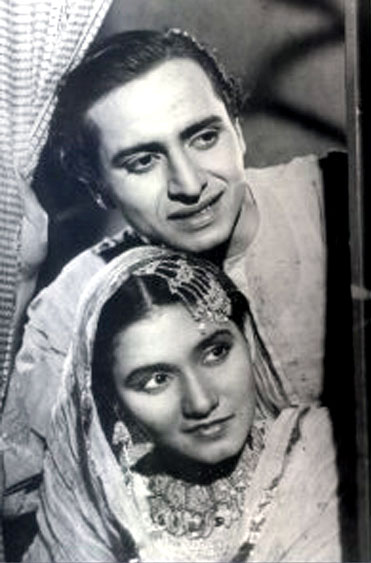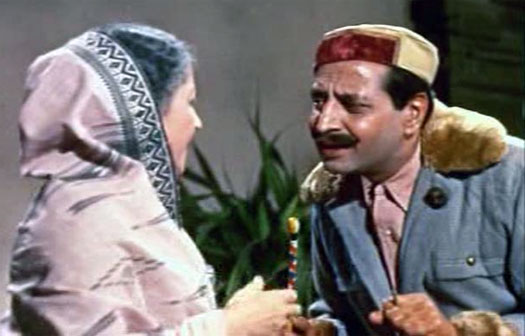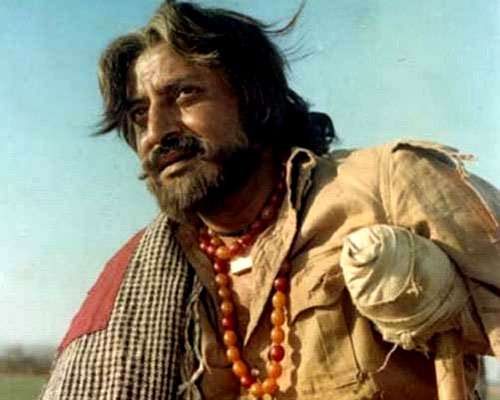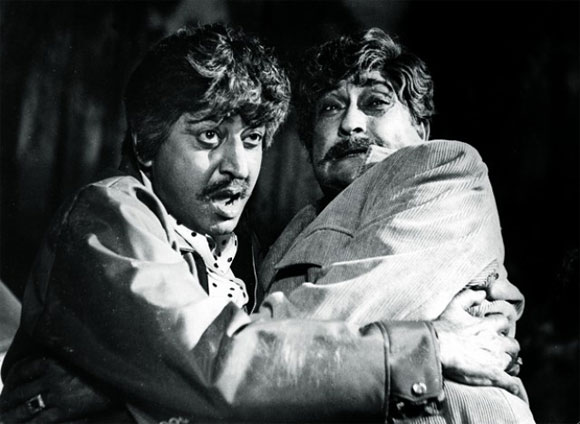 | « Back to article | Print this article |
The Life and Times of Pran
Veteran actor Pran, who breathed his last on July 12, was an unmatched force as the malevolent presence in most 1960-70s hits. Dinesh Raheja, who'd had the opportunity to meet the late actor, looks back at Pran's eventful life and filmography.
In the late 1960s, when the telegram was not an anachronism and inland letters were the norm and not a novelty, my cousin Subhash found out the postal addresses of certain leading stars.
They included Sadhana (my favourite), Shashi Kapoor (I wanted Shammi Kapoor but he had Shashi’s address) and Pran. Incidentally, ‘and Pran’ was the way his name appeared in the screen credits of many a film, so maybe subconsciously that is how I chose to write it even now.
I wrote rambling letters to all three.
Pran was the first to reply with an autographed photograph and a personalised note to boot.
Please click NEXT to read further...
Five minutes with Pran
As Hrishikesh Mukherjee’s Bollywood-themed Guddi (1971) established, Pran (who made a cameo as himself in the film) was a gentleman unlike his dipped-in-vitriol screen image.
Yet, years later, when I met Pran while working as a cub reporter for a film magazine in the mid-80s, a nameless dread held me in a vice-like grip thanks to all his evil onscreen avatars.
Mobiles had yet to make an appearance so I tracked him down to Filmalaya, a suburban studio in Mumbai. Since I was poaching on him without a prior appointment, I nervously knocked on the door of his makeup room.
After I had introduced myself, I blurted that I wanted to interview him.
His face was immobile. So I told him, “It’s for a feature called ‘Five Minute Interviews’. Besides you, I am also interviewing senior villains like Jeevan and Ajit. Can you spare me just five minutes?”
He agreed and was professionalism personified. However, after precisely five minutes, he tapped his watch and said, “Time up” but not before flashing me his famed crooked smile.
Pran's roles always found him deeply engrossed in one of the seven deadly sins
Onscreen, that celebrated smile portended not just the end of an interview but an avalanche of troubles for the film’s lead characters.
Lore has it that an unofficial survey of schools revealed not a single child named Pran in the 1970s.
Hindi cinema’s premiere menace of the 1950s and the 1960s could not have received a better compliment. Written with the tip of a scalpel, Pran’s roles always found him deeply engrossed in one of the seven deadly sins.
When he delivered threats in his sandpaper voice or smiled his sardonic sneer, you knew he was poaching on forbidden territory, whether it was a tycoon’s estate (Om Prakash in Dus Lakh) or the hero’s girlfriend (Vyjayanthimala in Madhumati).
Death was his just reward and signalled the end of the film; Pran was either offloaded down a waterfall (by Shammi Kapoor in An Evening In Paris) or came skiing down a slope while chasing Raj Kapoor and Rajshree only to be handcuffed by a posse of policemen (Around The World) or felled by an arrow that pierced his heart (Rajkumar).
Pran enjoyed a stunning career that straddled six decades
There was more to Pran than just his nefarious deeds -- he morphed into a heavyweight character actor from the late 1960s to the early 1990s and was a major box-office draw in blockbusters such as Zanjeer, Amar Akbar Anthony, Don, Bobby, Johnny Mera Naam et al besides fuelling films like Dharma to success with his own star power.
At the time of his death at 93, he had retired from work for around a decade and a half but he had enjoyed a stunning career that straddled six decades!
Pran's attire instantly coded him as a villain
While in his early 20s, Pran began in the Lahore film industry of pre-Partition India.
A photographer’s assistant, he debuted with famous producer DN Pancholi’s Punjabi film, Yamla Jat before moving on to play the hero opposite Noorjehan in Pancholi’s Khandaan (1942).
The Partition of India brought Pran to India where he embarked upon a period of struggle. The 1951 hit Bahaar in which he played a cad who impregnates a village woman but wants to marry Vyjayanthimala (making her debut) established him as a viperish villain.
In the 1950s, Pran made memorable several wanton characters like the zamindar lusting after the village beauty in Madhumati, the pimp in Adalat and the imposter in Tumsa Nahi Dekha.
Pran played the title role in the Meena Kumari starrer, Halaaku (1956) for which he cosmetically raised his eyebrows and sported a pencil-thin drooping moustache. Pran was convinced that costumes make a character and worked scrupulously on his appearance. His attire instantly coded him as a villain.
He was fond of the grand gesture but at times, they even had psychological underpinnings. As Raaka, the dreaded dacoit in Jis Desh Mein Ganga Behti Hain (1960), he kept running his hand on his throat as an unconscious indication of his fear of the hangman’s noose.
Pran provided a perfect foil to veteran Dilip Kumar as well as the rebel young star Shammi Kapoor
With the advent of the colourful 1960s, Pran’s roving bloodshot eyes ogled new heroines including Asha Parekh, Babita, Sadhana, Saira Banu and Sharmila Tagore.
Every hero requires a villain to validate his heroism and Pran was that man.
He was thrashed by every 1960s hero from Dharmendra to Manoj Kumar, even the chocolate faced Joy Mukherjee. Pran provided a perfect foil to veteran Dilip Kumar as well as the rebel young star Shammi Kapoor.
The escapist fare of the 1960s saw Pran smartly juxtaposition comedy and villainy to become a scene-stealer.
In Kashmir Ki Kali, it must have been difficult for character actor Nasir Hussain to keep a straight face when Pran threatens him, ‘Agar tumne Shampa ki shaadi mere shaath nahin ki toh main ushe zabardashti le jaaunga’ (Pran effortlessly pronounced Champa as Shampa, and every word containing the syllable ‘s’ as ‘sh’ to formulate a sound of his own). Shampa, incidentally, was played by a demure Sharmila Tagore, who was half his age.
In Dus Lakh, Manorama (one of my favourite comediennes) and he raised a mirth quake. When he meets Om Prakash for the first time, Pran says, ‘Hum tumko pasand kiya. Like you I’.
'Making large flourishes with a pair of kerchiefs, Pran enlivened Yaari hai imaan mera song in Zanjeer'
At the height of his chicanery, the ruthless rake was reformed by actor-director Manoj Kumar who cast him in a sympathetic role in Upkar (’67) as a maimed and philosophical mendicant, Malang Baba.
The heart-tugging song, Kasme vaade pyar wafa was picturised on Pran who bagged Filmfare’s Best Supporting Actor award.
A new chapter began in his career. Soon, Pran would have a song to himself in most of his films. The actor had another tremendous crowd-pleaser in Manna Dey’s Yaari hai imaan mera from Zanjeer.
As Sher Khan, who is the foe-turned-friend of Inspector Vijay (Amitabh), Pran exhibited a nimble pair of feet, probably dancing for the first time in his life. Making large flourishes with a pair of kerchiefs, the 53-year-old star enlivened this song.
Pran’s arrogant exchange with Inspector Vijay at the police station -- Iss ilaake mein naye ho sahib. Warna Sher Khan ko kaun nahin jaanta? -- drew deafening wolf-whistles.
The hits kept rolling on
The hits kept rolling in.
Aided and abetted by one of his closest friends and contemporaries, Ashok Kumar, Pran had the audience rolling in the aisles in Victoria No 203 (1972).
Ashok Kumar and he played two ageing but loveable con artists Raja and Rana in the film, and their natural joie de vivre is evident in the rumbustious number Do bechare bina sahaare.
Age caught up with him in the 1980s but the warhorse continued soldiering on. In one of his last major outings, the Sawan Kumar-directed, Sanam Bewafaa (1991), the rancorous malevolence in Pran’s eyes when confronting vengeful son-in-law (Salman) alternated with the grief for his daughter (Chaandni) aptly captured the polar aspects of Pran’s screen personality.
Pran is no more. And I will always have to live with the regret that I could only spend five minutes with him.
After all, Pran was ‘wanted’ for 60 years!
